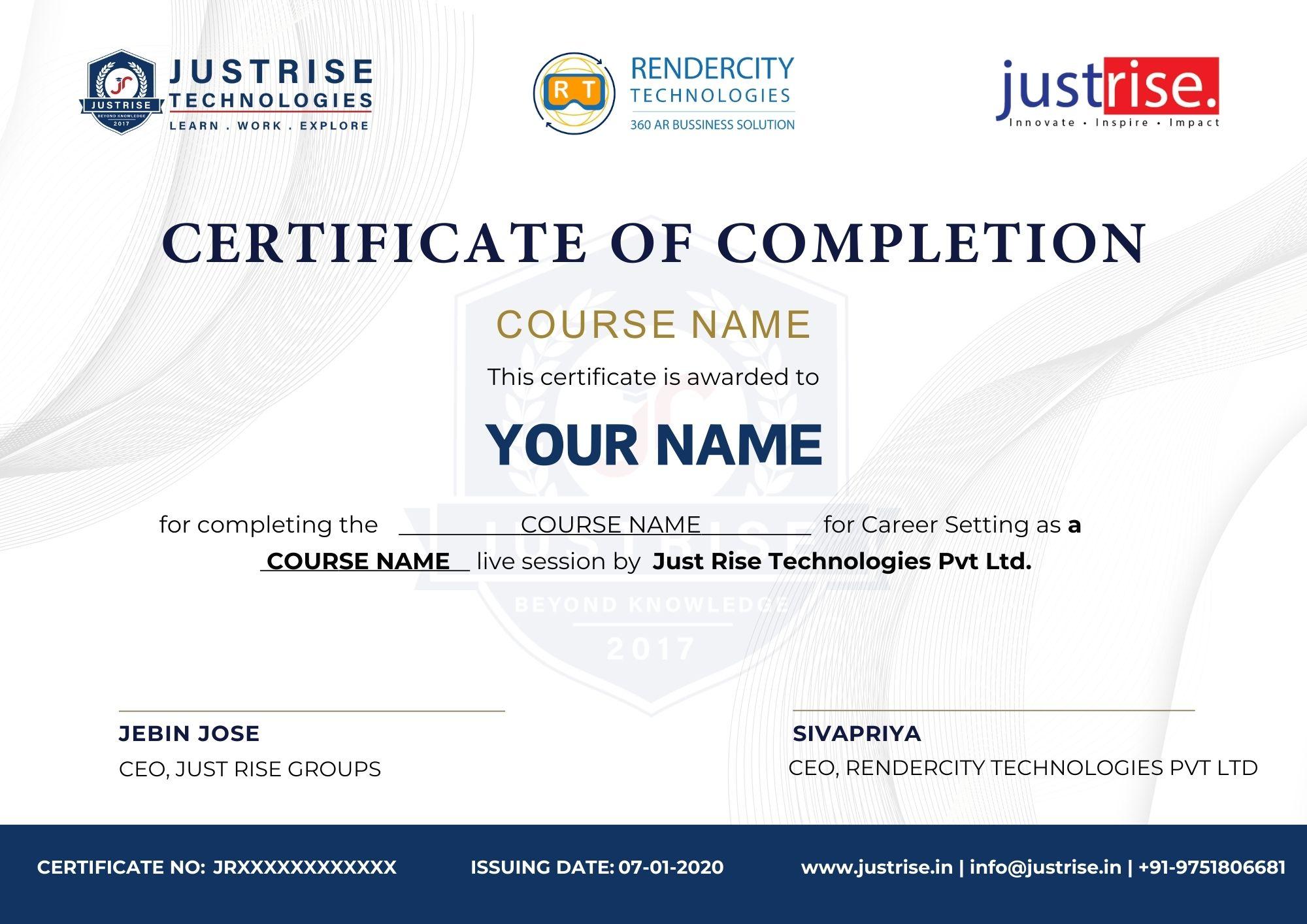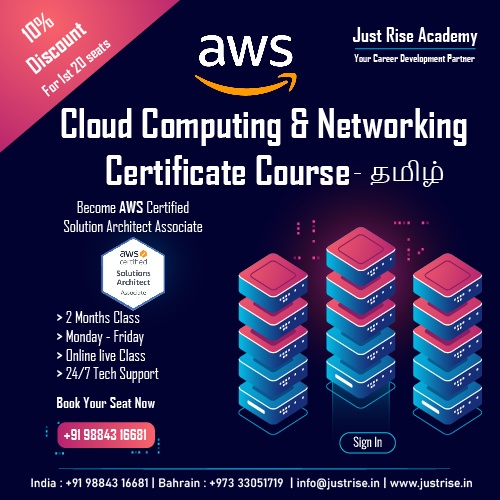AWS -Solution Architect Associate – Cloud Computing & Networking -Tamil
✅ Basic to Advance level course
✅ நேரடி ஆன்லைன் வகுப்புகள் on Zoom app
✅ சிறந்த பயிற்சி பெற்ற ஆசிரியர்கள்
✅ 2 Month வகுப்புகள்
✅ Software வழங்கப்படும்
✅ சான்றிதழ் வழங்கப்படும்
✅ வகுப்புகள் முற்றிலும் தமிழிலே நடைபெறும்
₹44,999.00
Requirements
- Knowledge : No Before Knowledge required since in this class we will teach you from very basic to a pro level
- Education Background: Any department student can enrol this course
- Internet Speed : Minimum 2Mbps for Smooth flow
- System Requirements : At-least Basic model laptop required to practice the topics
FAQ
You the buy now button to enrol this course
Yes.This Class is Live interactive class. Once you enrolled this course you will be added to our community, and we will share the zoom class link.
We will provide Recording of the class. So if you missed the class you can check the recording.
Don’t worry. Here Comes Our Unique Value.
“Once you are our student then you are our student for ever.”
You can re-attend the class again. We won’t charge any extra fee for this.
Certification Sample

Syllabuss
AWS – Solution Architect Associate
Module 1 – Introduction to Cloud Computing & AWS
– What is Cloud Computing
– Create an aws account
– Introduction to AWS S3, EC2, VPC, EBS, ELB, AMI
– AWS architecture
– AWS Management Console
Module 2 – Elastic Compute and Storage Volumes
– Introduction to EC2
– Pre-EC2, EC2 instance types
– Comparing Public IP and Elastic IP
– Demonstrating how to launch an AWS EC2 instance
– Introduction to AMIs, Creating and Copying an AMI
– Introduction to EBS
– EBS volume types
– EBS Snapshots
– Introduction to EFS
Module 3 – ELB & ASG
– Elastic load balancing
– Classic load balancer
– Application Load balancer
– Network Load balancer
– Gateway load Balancer
– Introduction to Auto Scaling, vertical and horizontal scaling, the
– lifecycle of Auto Scaling
– Components of Auto Scaling, scaling options and policy,
– instance termination
Module 4 – Simple Storage Service (S3)
– Introduction to AWS storagePre-S3 – online cloud storage
– S3 buckets and objects
– S3 versioning
– S3 encryption
– API, S3 consistency models
– Static website Hosting
– S3 CORS
– Security measures
Module 5 – Virtual Private Cloud
– What is Amazon VPC
– VPC as a networking layer for EC2,
– IP address and CIDR notations,
– Components of VPC – network interfaces, route tables,
– internet gateway, NAT,
– Security in VPC – security groups and NACL, types of VPC,
– what is a subnet, VPC peering with scenarios, VPC
– endpoints, VPC pricing and design patterns.
Module 6 – Databases and In-Memory DataStores
– What is a database, types of databases, databases on AWS
– Lunching an RDS instance
– AWS storage Gateway
– Introduction to Amazon Aurora, benefits of Aurora, Aurora
– Introduction to Amazon DynamoDB, components of Amazon DynamoDB,
– DynamoDB pricing and design patterns
– What is Amazon Redshift, advantages of Redshift
– What is ElastiCache, why ElastiCache
Module 7 – Access Management and Monitoring Services
– Pre-IAM, why access management
– Amazon Resource Name (ARN), IAM features
– Multi-factor authentication (MFA) in IAM, JSON
– IAM policies, IAM permissions, IAM roles, identity federation, pricing
– Introduction to CloudWatch, metrics and namespaces,
– CloudWatch architecture, dashboards in CW, CloudWatch alarms,
– CloudWatch logs, pricing and design patterns
– Introduction to Cloud Trail, tracking API usage
Module 8 – Automation and Configuration management
– What is AWS Lambda
– How Lambda is different from EC2
– Benefits and limitations of Lambda
– How does Lambda work
– Use cases of Lambda, Lambda concepts
– Integration S3 with Lambda
– What is Elastic Beanstalk, how does Beanstalk work, Beanstalk concepts, Beanstalk pricing
– What is configuration management
– What is AWS OpsWorks, AWS OpsWorks benefits
Module 9 – serve less solution Architecture
– Mobile Application
– Server less Website
– Micro service Architecture
– Distributing paid content
– Software updates pipeline
– Big data ingestion pipeline
Module 10 – Route 53
– What is DNS
– Route 53 – Registering a Domain
– Route 53 – EC2 Setup
– Route 53 CNAME vs. Alias
– Routing Policy – Simple
– Routing – weighted , Latency , health checks
– Routing – 3
rd party Domains & route 53
– Route policy – Geolocation and Geoproximity
Module 11 – Architecting AWS – whitepaper
– Important guidelines for creating a well-architected AWS
– framework that is resilient and performing
– Designing of fault-tolerant and high-availability architecture
– Resilient storage
– Decoupling mechanism
– Multi-tier architecture solution
– Disaster recovery solution
– Scalable and elastic solutions

